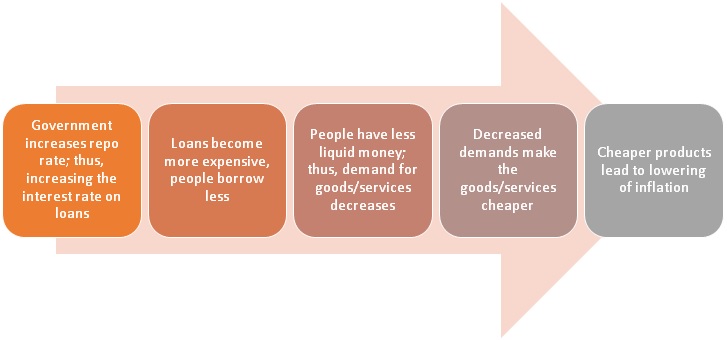What is Repo Rate in Mutual Funds & How does it affect your Investments?
There can be many scenarios wherein the commercial banks may suddenly require a lot of liquid money; scenarios like sudden redemption or withdrawal of funds in bulk or in order to maintain its Statutory Liquidity Ratio (SLR) or Cash Reserve Ratio (CRR) . When you face a shortage of funds, you probably go to your parents, but where can a bank go? The bank takes a loan from the Reserve Bank of India by keeping Government Securities as collateral with the RBI. At the end of the loan term, which is either overnight or 7 days, the bank repurchases the Government Securities by paying back the loan amount along with a pre-decided interest rate.
Hence, the repo rate is the interest rate at which the RBI lends money to the commercial banks to help them enhance their liquidity. In case the bank defaults in paying the money back to the RBI, the latter sells the G-Secs that were kept collateral, further in the market.
Let us see an example-
As an illustration, considering a hypothetical repo rate of 6.5%, below is the bank’s borrowing process-

Bank’s repaying process-

What’s the significance of Repo Rate for our economy?
Regulating the repo rate is one of the tools that the RBI adopts, in order to regulate the inflation and growth in the economy. Consider a situation where the inflation in the economy is high; the RBI will increase the repo rate in order to bring it down. Let’s see how that works:

How Repo Rate affects your mutual fund investments?
Debt Mutual Fund schemes-
Considering an example, assume that a 10-year Government bond was issued at face value of Rs 100 and interest (coupon) rate of 8%. This implies the yield in this bond is Rs 8. Now, if the repo rate increases and the lending rate is increased to, say, 10%, that would mean that the yield for the new bond issued will be Rs 10. This will bring down the demand of the 8% bond since the 10% coupon rate promises better returns. To make the former more attractive, the face value of the bond will be decreased to, say, Rs 90. The yield for this bond now becomes 8.89% (8/90*100), which is higher than the original, hence making it more attractive. Hence, an increase in interest rate is directly proportional to the yield and inversely proportional to the face value.
Debt mutual fund schemes invest in fixed income securities like Government bonds; hence, a decrease in repo rate may make the debt schemes more attractive as it may increase the NAV of the debt schemes. The margin of gain will depend on the average maturity and the securities the scheme holds.
Equity Mutual Fund schemes-
Equity schemes see an indirect impact of the repo rate changes. For example, if the interest rates drop, that may result in more funds being available to the corporates, which can boost their earnings and cashflow thereby leading to higher stock prices. This shift may not be seen immediately but may happen gradually. This results in positive sentiment in the equity market and the gains may thereby increase for the schemes that invest in equity.
As you can see, a change in the repo rate can directly or indirectly affect your debt and equity-linked investments. But before making any shifts in your investing strategy because of the repo rate regulations, it is recommended that you consult your financial advisor. Watch this space for more such jargon-decoding!
